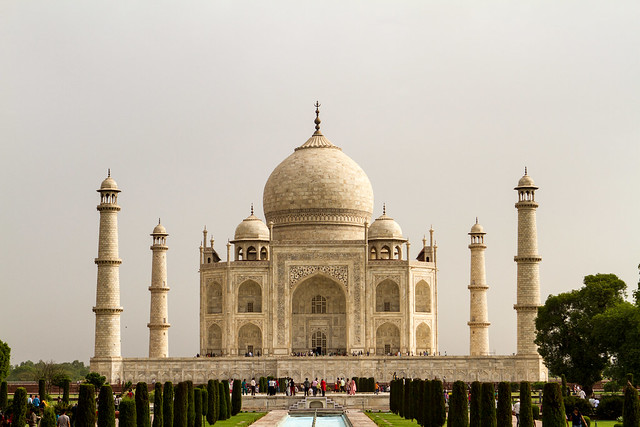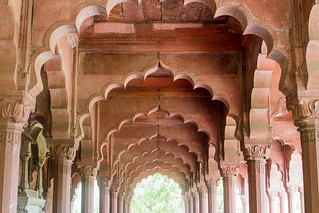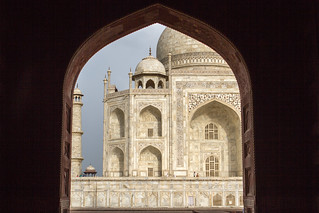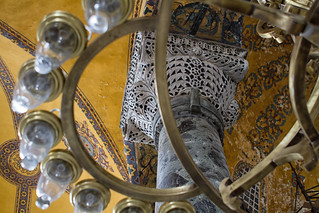
In June I went to Pune in India for “handover training” on the project which has been the main focus of my work for three years now. I didn’t see much in Pune but since It was a three-week trip I managed to take a weekend trip with two of the other guys from the project. Of course the must see attraction for one’s first time in India is the Taj Mahal [wikipedia.org]!
In order to get to the Taj from Pune we flew to New Delhi early on Saturday morning. Once there we met up with a hired driver to drive us the 200+ kilometer to Agra. With a quick stop in Delhi to see the Red Fort [wikipedia.org]. The Red Fort was built by Shah Jahan, the same Mughal Emperor who built the Taj, and was the residence of the Mugal Emperors for 200 years until “the Britishers” took over.

You can see how the Red Fort must have been a beautiful place, and could be an amazing place to visit. However… it is in pretty bad shape. Trees down, all the water fountains under some sort of renovation — and what appears to be the workers on this project living with their family under one of the buildings in the middle of what should be a pool. We saw a woman down there doing the laundry and the kids playing.
All in all the Red Fort was not worth the two hours in the 40+ degree Celsius Delhi summer heat.
After a quick fast food lunch — the land of vegetarian McDonald’s “burgers”! We piled in our ride for a tour of India’s $2 Billion Yamuna Expressway [wikipedia.org]. Halfway to Agra we took a short break for our driver to replace a tire and then a few miles down the road to have the tire fixed. I haven’t seen a car tire with an inner-tube before. I think those went out of style in the US before I was born.
Eventually we did get to Agra. Then we go lost. Seem the driver didn’t know the way to the Taj. We drove the wrong way a few miles — which takes some time in Agra — before he asked for directions and we backtracked to the Taj.

Once there we were told there was only 15 minutes until the ticket counters closed – one hour before the Taj itself closed for the night. And that it was a 600 meter walk from the parking area to the ticket counters. We elected to walk it, running a gauntlet of trickshaw drivers, camel handlers, horse masters and donkey cart drivers who wanted to sell us a ride. They didn’t give up until we were within about 100 meters of the ticket gates. The constant touting was not the part of the walk that leaves an impression. All tourist hot-spots have their equivalent. The smell is the part that sticks with you. It was like walking through an open sewer. It was, without a doubt, the worst smell I have ever smelled. Worse than the pit farms near my grandparents house. Worse than smell of Bangkok back alleys. I mean, you could see horse shit, donkey shit and even camel shit on the road — and you could smell it when it was there. But this was a constant smell of doom, an apocalyptic odor. Something I will never forget. We never identified its source but luckily it was confined to the 600 meters between the parking lot and the ticket counters.
We made it to the ticket counters in time, got our tickets and our booties — which one must ware inside the Taj itself. By coincidence that night was a full moon, and the Taj is open for night viewing during a full moon. We had planned to get tickets for the full moone viewing, unfortunately you can’t just buy tickets for it at the ticket counter — you have to buy them 24 hours in advance. The website makes not mention of this and we were unable to get them to sell us tickets so despite the coincidence we were unable to take advantage of our one night being the a full moon.

We spent our hour wandering around and taking photos before the guards kicked everyone out and we had to make our way back through the stench. Thankfully it was less intense, maybe the wind have shifted. We spent a night in a nearby hotel.
Next morning we went back for sunrise photos but low hanging clouds kept it from being too dramatic. In any event we walked around for a good two hours taking in the beauty of the Taj itself and the surrounding buildings. The Taj deserves all the praise for its beauty. There is not much to it inside, it is after all a mausoleum. The outside is the glory. It is an amazingly beautiful building. If it had not been for the need to get to Delhi to fly back to Pune for work I could have spent all day just wondering around the Taj grounds and admiring the beauty and the details. Despite the sunset and sunrise being less than spectacular and the daytime haze making for a dull gray sky I took an enormous amount of photos — I doubt I will ever go back.









